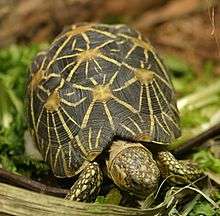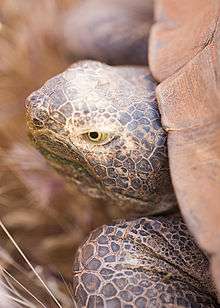Geochelone
Geochelone tortoises, which are also known as typical tortoises or terrestrial turtles, can be found in southern Asia. They primarily eat plants.
| Geochelone Temporal range: Miocene to present | |
|---|---|
 | |
| G. elegans | |
| Scientific classification | |
| Kingdom: | Animalia |
| Phylum: | Chordata |
| Class: | Reptilia |
| Order: | Testudines |
| Suborder: | Cryptodira |
| Superfamily: | Testudinoidea |
| Family: | Testudinidae |
| Genus: | Geochelone Fitzinger, 1835 |
| Species | |
|
G. elegans | |
Geochelone is a genus of tortoises.
The genus consists of two extant species:
- Indian star tortoise (G. elegans)
- Burmese star tortoise (G. platynota)
A number of tortoise species have been recently removed from the genus. This taxon as formerly defined was "polyphyletic, representing at least five independent clades".[1] Tortoises removed include members of Aldabrachelys (from the Seychelles and Madagascar), Astrochelys[2] (Madagascar), Chelonoidis (South America and the Galápagos Islands), Stigmochelys[2] and Centrochelys (Africa), and the extinct Megalochelys (southern Asia).
"Self-righting" shell
The form of the shell of the Indian star tortoise resembles a gömböc, allowing it to turn over when lying upside down very easily.
References
- Le, M.; Raxworthy, C. J.; McCord, W. P.; Mertz, L. (2006-05-05). "A molecular phylogeny of tortoises (Testudines: Testudinidae) based on mitochondrial and nuclear genes" (PDF). Molecular Phylogenetics and Evolution. 40 (2): 517–531. doi:10.1016/j.ympev.2006.03.003. PMID 16678445. Archived from the original (PDF) on 2012-03-16.
- Fritz, U.; Bininda-Emonds, O. R. P. (2007-07-03). "When genes meet nomenclature: Tortoise phylogeny and the shifting generic concepts of Testudo and Geochelone". Zoology. Elsevier. 110 (4): 298–307. doi:10.1016/j.zool.2007.02.003. PMID 17611092.
- Geochelone Report in Integrated Taxonomic Information System. Retrieved January 12, 2008.
External links
- Chaco tortoise media from ARKive

- Care tips
